#constructed writing system
Text
I'm on Reddit btw. Mainly posting neography:
#neography#neographer#neographying#neographist#conscript#conscripts#constructed script#constructed scripts#fantasy alphabet#sci fi alphabet#constructed writing system#constructed writing systems
4 notes
·
View notes
Text
Do You Know This Disabled Character?

Murderbot has social anxiety and Post Traumatic Stress Disorder
#poll#polls#disability#disabled characters#id in alt text#murderbot#I love it very much#I would like to note that technically Murderbot is not a cyborg#it is a construct#as a cyborg is a human with mechanical parts (for a simple definition)#and Murderbot is not human#y’all should go read All Systems Red I really liked it and I don’t particularly like reading sci-fi#mod a was summoned from the void to write tags for once
107 notes
·
View notes
Text

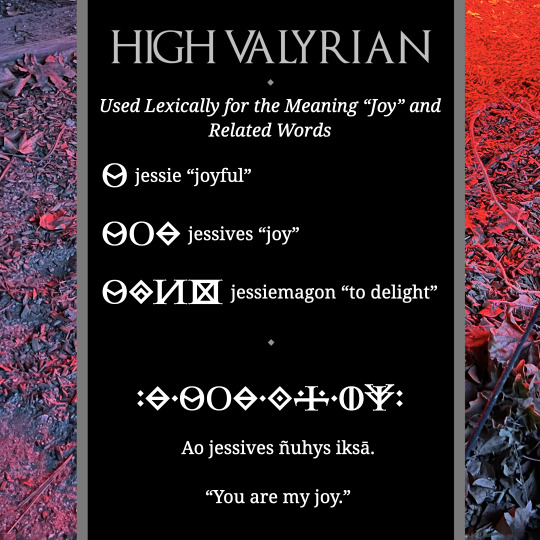


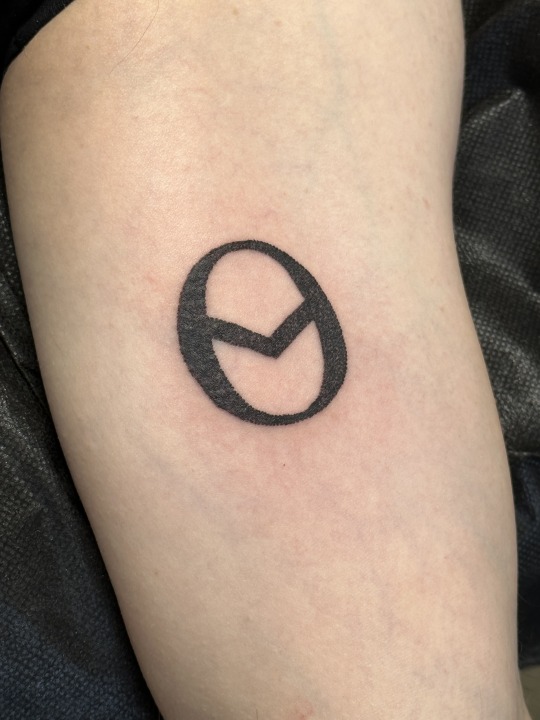

The High Valyrian adjective jessie "joyful" was coined in honor of my fiancée, Jessie Sams, and the glyph was made thinking of her. I've known Jessie for ten years at this point, but our lives led winding paths that eventually led us to each other. We started working together in 2019 on Freeform's Motherland: Fort Salem, and I've wanted to work with no one else ever since. When I proposed to Jessie, I gave her a ring with a Valyrian inscription inside. That inscription featured her name glyph: Ao jessives ñuhys iksā, which means "You are my joy".
I'd never planned on getting a tattoo in my life, but we came up with an idea that meant a lot to both of us. I'd created a glyph for the word "joy" in High Valyrian and based the sound of that word on Jessie's name. She, in turn, had created a word based on my name in her language Zhwadi (it means "create"). Her writing system is also logographic, so there's a character associated with that. Consequently, we each decided to get each other's "names" tattooed on ourselves. Now a part of us will always be with the other. :)
#conlang#language#game of thrones#house of the dragon#got#hotd#valyrian#high valyrian#quothalinguist#zhwadi#orthography#neography#conscript#constructed script#writing system#tattoo
155 notes
·
View notes
Text
The Collective Seraphic Writing System
This post is going to be the one dedicated to explaining how the Seraphic writing system works. This writing system is entirely digital, as physical writing is no longer in everyday use throughout the Collective, so it's a bit inconvenient to actually write out. It's also weird to read, because it's written in a way that makes the assumption that you know how to speak and understand Seraphic, but I'll try to explain what I can.
Seraphic has two written forms: longform and shortform. Longform is used primarily to teach young instars how to read and write, and as a way to show how a shortform word is meant to be read. Shortform is the main form of writing, and due to its complication it's usually put off for a year or two before being taught in pupariums. Shortform is the method I'll be teaching today. It's primarily morpho-phonetic, with elements of both an alphabet and grammatical logograms, and is written bottom-to-top and right-to-left in reverse boustrophedon (the path of writing goes up, flips 180°, and goes back down). Because of this, you're expected to be able to read both right-side-up and upside-down. For this post, I'll be using an example sentence to highlight specifics areas of the writing system, as shown below:

It reads: nJasāğn k'œ̄nan ālxōr e-fya.
"There are 16 dull knives on the floor."
There are seven elements you need to be aware of when writing in Seraphic: the alphabet, class cartouches, procedural and plural ligatures, preposition glyphs, tone diacritics, numerals, and punctuation. I'll be going through each one step-by-step.
Alphabet

The alphabet makes up the majority of Seraphic writing. There are 30 consonants and 6 vowels, and they all arrange into syllable blocks called "cells". Each consonant takes one of three forms depending on if it is at the start of the syllable, before a vowel, or at the end of a syllable. The alphabet is featural, meaning that the way each letter is written is meant to encode its pronunciation. Here is the alphabet in full:

Each consonant (excluding the ejectives) showcases the three variant forms it can take (similar to capital and lowercase letters in the latin alphabet). The largest, leftmost character is the form that hosts the interior vowels within it. The rightmost vertical form is used when preceeding another consonant, and the upmost horizontal form is used at the end of syllables. If a syllable contains a syllablic consonant, the main consonant will have no vowel within it and instead a syllable-final form of one of the syllabic consonants (r, l, m, n, or ŋ) placed on top of it.

Concerning vowels, they are solely meant to be written within consonants, acting sort of like internal diacritics. They cannot exist on their own, nor can more than one be written within the same consonant (Seraphic doesn't allow diphthongs), and if a vowel must be written by itself it is written within the glottal stop letter ' (in this instance acting as an independant vowel holder).

These rules apply to individual syllables. In multi-syllabic words, each syllable cell is arranged together in a specific way based on the number of syllables in order to keep the line uniform and compact.
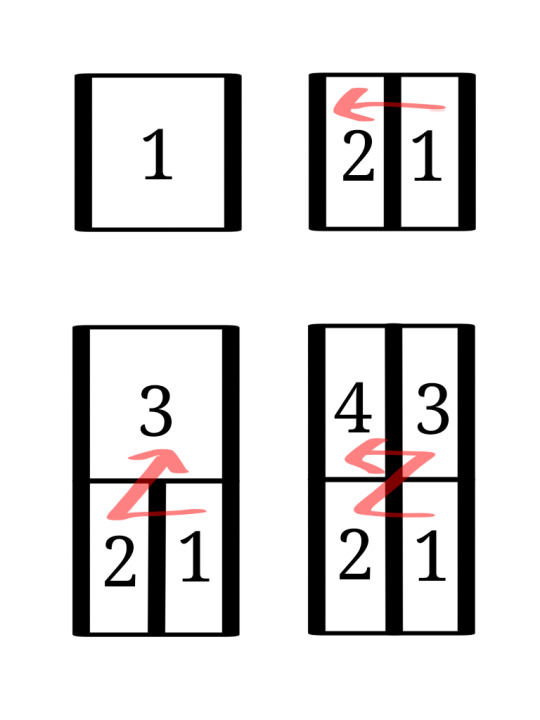
the flow of reading word-internally definitely follows the overall direction of writing (bottom-to-top, right-to-left) so broken down an entire word will usually look like this when written:

Seraphic written in longform will be written entirely using the alphabet. Spaces are put between words, punctuation and numeral symbols are still used, and tone diacritics may be included as well, but otherwise it's entirely spelled out in this way. Writing this way makes the text as a whole quite longer, and can come off as childish or imply you're a new learner of Seraphic, so shortform will usually be used in official contexts. In shortform, alphabetical letters are restricted to non-declined parts of nouns, adjectives, and proper nouns.
Class Cartouches

In Seraphic, there are seven noun classes: Solar (people), Astral (animals), Vital (plants), Terranean (places), Metallic (objects), Lunar (concepts), and Oceanic (everything else). Similarly, the writing system employs seven symbols called "class cartouches" to encode which noun class a word is in. This is drawn from this writing system's predecessor, the Aeonic Seraphic alphabet, that also used glyphs to notate class. These are the seven noun class cartouches:
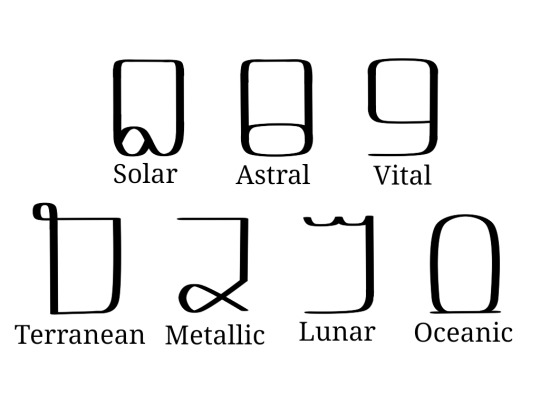
The thing about the class cartouches is, not only is it morphological, but it's also phonetic. A noun is never spelled out in its entirety, usually only part of it is. When a class cartouche is used, it's supposed to stand in for the class prefix itself without having to additionally spell the class prefix in the rest of the word. For example, in the word zājlux (tail), the "-jlux" would be spelled out, and the solar class cartouche would be drawn around it to stand in for the "zā-". Even though you don't write it, you still know it's there because of the class cartouche. Because of the nature of the noun class prefixes, and how many different forms they can take, it can be daunting to have to guess if you're supposed to pronounce a word with a "za-" or a "zo-", but there are patterns to which prefix (and thus, declension patterns), is meant to be read depending on what the following sound is.
Solar class
read as zā before f, v, s, z, c, j, pf, ts, tc and any cluster of two consonants (e.g. zāsā, zāfr, zājlux)
read as zō before x, ğ, h, ', and kx (e.g. zōxō, zōxur, zōğœcl)
read as zē in stressed syllables, and occasionally before consonant clusters (e.g. zēzmp'ux, zēzt'e, zēvasax)
read as s before vocalics (vowels and syllabic consonants), r, l, w, y, n, t, d, p', or k' (e.g. srāc, sēr, sōğœc)
read as ts before t', the ts replacing the t' entirely in pronunciation, for example tsn would be written as (Solar)t'n (e.g. tsn, tsā, tsłzaf)
Astral class
read as ğr before f, v, s, z, c, j, x, ğ, h, pf, ts, tc, kx, p', t', k' and and cluster of two consonants (e.g. ğrzles, ğrxur)
read as x before vocalics, r, l, w, y, ŋ, k, g, p', or t' (e.g. xūc, xŋox)
read as kx before k', the kx replacing k' in pronunciation (e.g. kxa)
Vital class
read as wā before r, l, w, or y (e.g. wāya, wārāc, wāwax)
read as wō before k', k, g, x, ğ, ŋ, or kx (e.g. wōk'ł, wōxur, wō'ōf)
read as wē before consonant clusters (e.g. wēzles, wējlux, wējlozln)
read as ū before n, m, p', p, b t', t, d, f, v, s, z, c, j, pf, ts, or tc (e.g. ūt'u, ūp'n)
read as w before vocalics (e.g. wē, wīn, wājr)
read as wī occasionally before consonant clusters (e.g. wīzya)
Terranean class
read as va before f, v, s, z, c, j, pf, ts, tc and any cluster of two consonants (e.g. vafl, vasērn, vasa)
read as vo before x, ğ, h, ', kx, and consonant clusters (e.g. voxāl, vodsā, vojrayux)
read as vu in stressed syllables and occasionally before consonant clusters (e.g. vujlux, vulvren, vuzajni)
read as f before vocalics, r, l, y, w, m, n, ŋ, p, b, t', or k' (e.g. fe, fruvn, fmağo)
read as pf before p', pf replacing p' in pronunciation (e.g. pfan)
Metallic class
read as ja before f, v, s, z, c, j, pf, ts, tc and any cluster of two consonants (e.g. jafa, javlni, jawaya)
read as jo before x, ğ, h, ', and kx (e.g. joxl)
read as c before vocalics, r, l, w, y, n, t, d, p', or t' (e.g. can, cya, cenaŋx)
read as tc before t', the tc replacing the t' entirely in pronunciation (e.g. tcłvr, tcāŋğl, tcū)
Lunar class
read as la before r, l, w, or y (e.g. lara, layeğr, lalel)
read as lo before k', k, g, x, ğ, ŋ, or kx (e.g. loxir, loğn̄, loxel)
read as le before consonant clusters (e.g. levp'ā, levren, lejt'ān)
read as li in stressed syllables and occasionally before consonant clusters (e.g. liwayi, lit'n̄, livasāx)
read as y before vocalics (e.g. yar, yu, yawu)
read as l/ł before n, m, p', p, b t', t, d, f, v, s, z, c, j, pf, ts, or tc (e.g. lce, łzēwok'u, lvulvren)
Oceanic class
read as a/ā before m, n, p', p, b, t', t, d, s, z, f, v, c, j, pf, ts, tc, w, r, y, l, and all consonant clusters (e.g. ap'i, āt'ē, ācèya)
read as o/ō before ŋ, k', k, g, ', x, ğ, h, and kx (e.g. ōxūr, ōxān)
read as aw/āw before vocalics (e.g. awun, awaf, awaman)
Of course these rules are not hard set, and there are several instances where a written word contradicts these rules or even when two words end up spelled the same, but for the most part these rules will generally be consistent for most written words. It seems like a lot to remember, but usually it's a thing that you eventually develop a sort of "ear" for.

Procedural and Plural Ligatures

The procedural and plural ligatures are additional glyphs used to mark, respectively, the procedurals and the plurals of a noun. The procedural are written at the bottom of the noun (since Seraph is written bottom-to-top and these are prefixes of course), and there are 12 separate procedural symbols in use. Similarly, the plurals, being suffixes, are written at the top of the noun and contain only three symbols (the singular is usually unmarked). They are as follows:
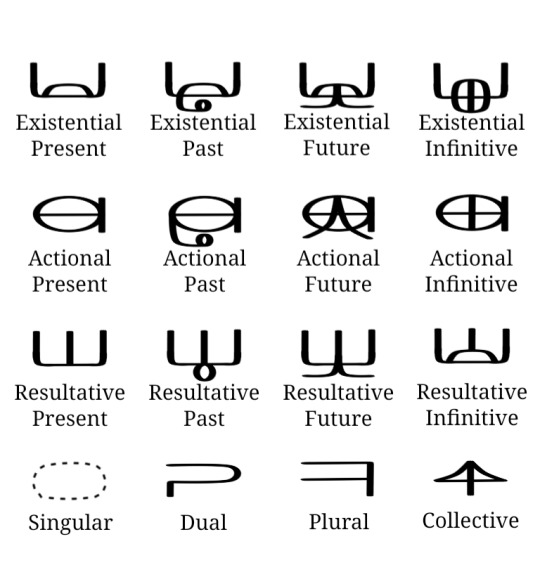
The plural ligatures attach to both nouns and adjectives freely, but in order for a procedural ligature to attach to an adjective, the adjective needs to be put in the oceanic class and subsequently written with the oceanic class cartouche. Additionally, if you want to write remote past/future forms for each procedural, you would need to attach the resultative present ligature underneath the preexisting past or future ligature (these conjugations haven't developed their own separate ligature forms, so they follow the tradition of using the resultative in addition as semantically that is where the remote forms originated). I don't really have a way to show you how to pronounce the plural forms, as even though the different pronunciations are pretty few they're actually pretty inconsistent on which one goes where. It's just one of those things you kinda have to already know. You can check the introduction to Seraphic post to see what forms the plurals can take, but otherwise it's basically, like, memorization. The procedurals on the other hand DO have a predictable pattern of pronunciation, but each tense has a different form based on what class and declension the noun is in, and with six tenses and seven classes each with at least three different declension forms, it's definitely something I can't summarize here. Again I HAVE to make a separate post for that because the declension forms are vital to knowing how to decline properly in Seraphic.
Preposition Glyphs

This section will probably be the easiest to explain really. The preposition glyphs are pretty easy to recognize. They're written in between words, attaching to both of them instead of floating freely like regular words are. There are 19 glyphs for the 19 prepositions, and they don't really change form. Sometimes, if occurring at the beginning of a sentence, they'll have one end sorta lopped off, but not everyone follows through with this convention. Here are the glyphs listed below:
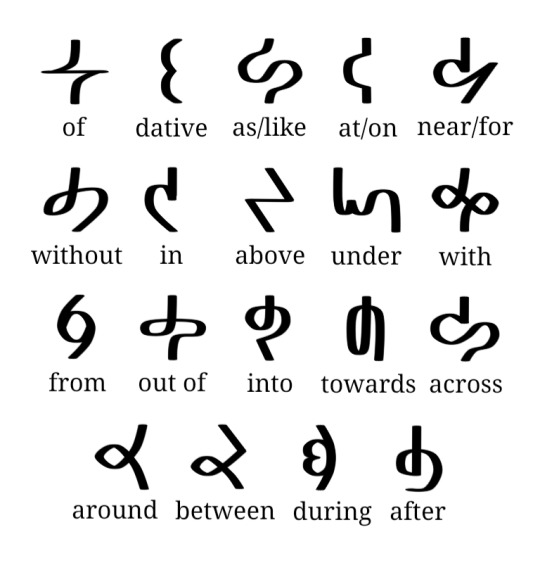
Two or more prepositions can't occur sequentially, it's a very one-at-a-time situation, although in colloquial speech you'll see two prepositions being used in certain instances.
Tone Diacritics

Seraphic is a tonal language, and luckily it has diacritics to indicate the tones. They frame the words on each size, being used on both nouns and adjectives where applicable. You'll usually see them in formal contexts like government documents and letters of address, on signs and boards and menus and any kind of display especially in highly populated areas, in use by those whom are just learning Seraphic and don't have a hang on remembering all of the tones yet, and just in any context where clarity of literacy would be important. In everyday colloquial text conversations and things the tone diacritics will be usually dropped as context is sufficient enough to know, although tone diacritics may be reintroduced to differentiate homonyms that are distinguished only in tone (e.g. lxal "power" vs. łxāl "day"). There are eight individually recognized tone diacritics:

The low tone is the base tone and is usually left unmarked, so there's no sign for just the low tone. When a low tone transitions to a rising or falling though, the low transition diacritic will be used to connect the two. Many of these diacritics are usually connected consecutively when a word requires it, flowing as if they're one larger tone diacritic. This can give a whole host of unique tone symbols, but for the most part, all of the tone symbols can be broken down officially into the 8 diacritics. There isn't a 1-1 correspondence between individual tone diacritics and syllables within a word, usually you can know from context and just knowing how the word is pronounced. For example, the word łxāl would be written with one high tone marker even though the word is two syllables, but it's meant to infer that the entire word is pronounced with an even high tone. Here are some additional examples:
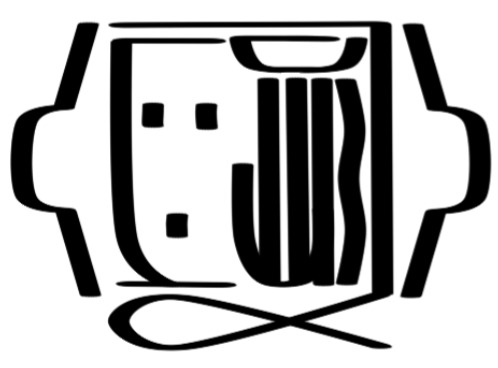
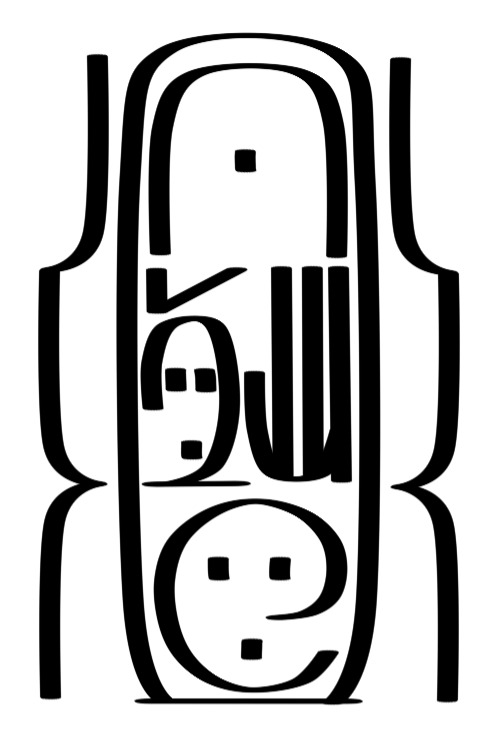
The top example is the word jalzègxa "chronicle". You can see that it uses the two low tone transitions to connect to the central falling tone, representing a low-falling-low relationship. The word below that is māzefādnu "hourglass". It employs a high-low-high, and then a high-low, with the last high-low meant to merge with the high-low-high. So truthfully it's meant to be interpreted as high-low-high-low. There's a lot of possibilities, but breaking it down will simplify what tones are being used specifically.
Numerals and Punctuation

This final section will discuss Seraphic numerals and punctuation. Now, unlike in most human languages which uses base-10, having 10 unique symbols to represent the values of 0-9, Seraphic uses base-16 and represents the values 1-16 with 16 individual symbols. In base 16, we would write 16 as 10, standing for one set of 16 and zero sets of 1. It's written in positional notation like arabic numerals, where each position represents a power of 16 (instead of a power of ten like in base-10). Here are the numerals:
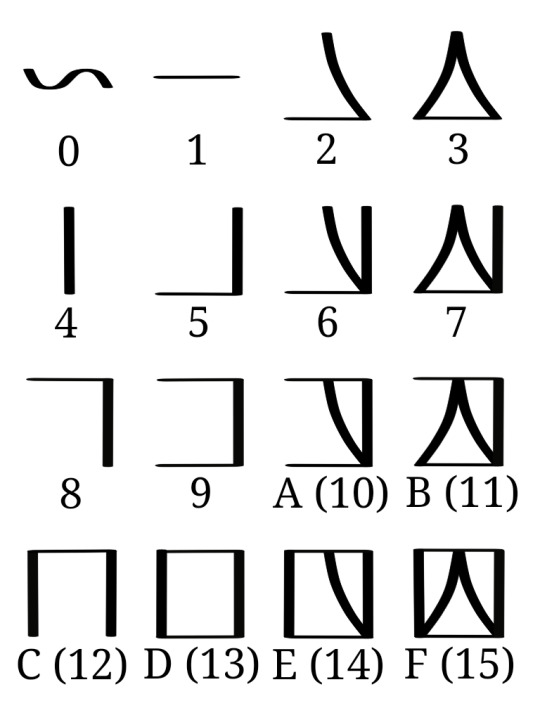
If you were to write a number like 299,792,458; you'd convert it into base-16 which would be 11,DE7,84A; and since Seraphic numerals are grouped in 4 instead of 3 it would actually be 11DE,784A. This is how you'd write that:
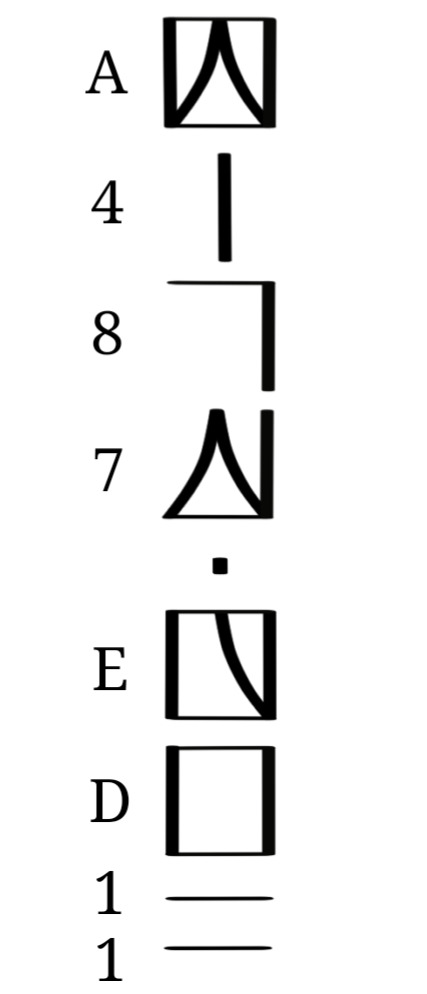
Both Arabic numerals and Seraphic numerals describe the same amount of things, they just group things differently. We group in sets of 10, they group in sets of 16.
As for punctuation, there are only 5 marks that's in standard use, and these are them:
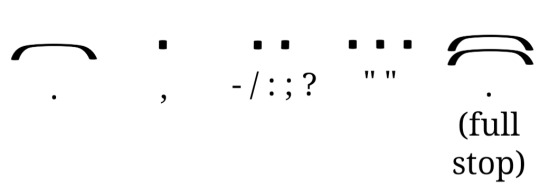
Single bar - separates individual sentences.
Single dot - separates clauses for clarity, separates numerals into groups of four.
Double dot - separates individual words such as in lists or replaces a single dot when separating clause groups.
Triple dot - Distinguishes quotes and dialogue, as well as highlighting names, terms, and titles.
Double bar - used to end full paragraphs/passages instead of a single bar.
Overall, that's pretty much everything I can detail about how the Seraphic writing system works! It's complicated but it was very fun to develop and boy was it satisfying to get it to work. Hopefully you'll now be able to decode a little better Seraphic writing, and maybe even write something of your own!

ŋKowīci cu-stux 'ōf tsa-levp'ā cu-zāsláf pi-lizt'n ğōdjasa! (Thank you all so much for reading!)
#conscript#constructed script#neography#conlang#constructed language#artlang#writing system#orthography#seraphic#collective seraphic#whoa boy this one is even longer#had to do a lot of writing and doodles for this#of course i needed them so itd all make sense#i needed to provide examples#either way i hope this made any sort of sense#ill provide the declension forms soon enough and that should be relatively shorter#idk if it'll be easier to explain though#eh whatever
44 notes
·
View notes
Text
it's really fun to think that everyone's lives before lifesteal sucked so despite all the murder and killing and paranoia they're having a pretty good time.
#im slowly constructing the world lifesteal takes place in to me#i never really thought about it before making my pre ls fic but now mmmmmm#it exists outside of the normal world#maybe that means its somewhere no one besides them has discovered yet or perhaps its to do with the magic system#another plane mirroring the traditional world but made so they can alter it as much as necessary#idk how season 1 would fit into my idea so im mostly gonna say s1 consisted of finding people and ignore it otherwise#its mapicc and spoke adventuring together and picking up parrot and everyone#throughout it it was made clear spoke should not be the one controlling their “world”#partially not wanting to partially because parrot kinda inserted himself into the position#need to think about this all more... i love it#rambles#lifesteal#writings#world au
17 notes
·
View notes
Text
I keep thinking about the times that someone has looked at the idea of writing their language and gone '…yeah no I'm gonna fix that' or 'yeah I want a piece of that action' and made it happen, for any reason. And I'm gonna make noises about it for a little bit. Maybe highlight a couple of things.
You've got King Sejong in Korea going "OK. The script we're using now is hella complex and …Chinese. I want something that's easy enough for a farmer to learn. And maybe to pay his taxes with." And he works out hangul, neat and logical and frequent winner of Best Writing System awards if such things exist. (And then the nobles don't like it because how are they supposed to look smart if the peasants can write too?)
You've got Sequoyah, thinking the settlers he's doing business with might have at least one good idea in this whole 'talking leaves' system they're using. So he throws himself into working out a syllabary that works for the Cherokee language even when his friends and family think he's losing the plot or he's possessed or… Anything. But he hangs in there. Teaches his daughter. Proves that this is something worth it, and goes on to see the syllabary he created become official and used throughout the Cherokee Nation.
These are the best known ones. But how many are there out there?
There are systems where a missionary or someone similar's come into a place, and gone 'hm, Latin ain't cutting it for writing this' - the Cree syllabics and their extended Canadian family fall into this box, though there's at least some accounts that dispute the usual story. (Given that a lot of those sort of stories come down to 'so we can make a Bible at these people', it's fair to put a big old asterisk on them, but… they're a thing.) Getting away from that issue, though? There's local creators making a bespoke system for their language when the ones they'd picked up from outside just don't fit the sounds or grammatical patterns. Writing systems that can really belong to a language and its people.
While it's absolutely not my place to say whether something is good or bad - the only people who can do that are the language users and community the script was made for - there can't help but be a few that catch the eye. For example, I'm quite fond of the Ditema tsa Dinoko script - it's a pretty recent creation from South Africa as a script for a wide range of Bantu languages, using compact triangular blocks in a way that reflects traditional patterns from Sesotho tradition. From my outside perspective, it's an elegant script. It's just one example, though - there's many creators in Africa who have done similar things, sitting down and making a script that their language needs and that isn't being shoved on them by… yeah. Vai and N'Ko are the biggest examples but there are so many! Moving on, in Oceania, we find the Avoiuli text from Vanuatu, designed so that any one character can be drawn with one stroke in the sand… and elsewhere, the scripts being created to use with signed languages which haven't used them in the past…
If I were to try and go into all of them, it'd be a whole essay. And I'd probably miss some as I'm an outsider nerd without access to the deep literature on some of this stuff. Instead, I'll link to The World's Writing Systems as an index to browse through - unfortunately, it doesn't allow searching by how the writing system was created. But there are plenty of indigenous scripts listed there too that deserve their own deep dive. (The fact it lists con-scripts specifically made for fiction… eh.) Their icon comes from the Afaka script, for the Ndyuka creole in Suriname. A lot of the letters are quite pictorial in nature - including the 'ka' in WWS's icon. Gotta say, that's a way to make things memorable.
…anyway, that's my ramble for today. Just gonna wrap with this source which I haven't fully investigated yet, and Endangered Alphabets which isn't so much for deliberately constructed scripts but (unsurprisingly) for endangered ones in general, and as such plain deserves a link.
Now I go back to my own scribbling. Maybe I'll finish a con-script enough to show off one day. Even if one rather smaller in goals.
#writing#writing systems#language#constructed scripts#conscript#long post#i like words :3#just a ramble
43 notes
·
View notes
Text
I've been conlanging and today I want to show you the writing system of Ashisota, my conlang.
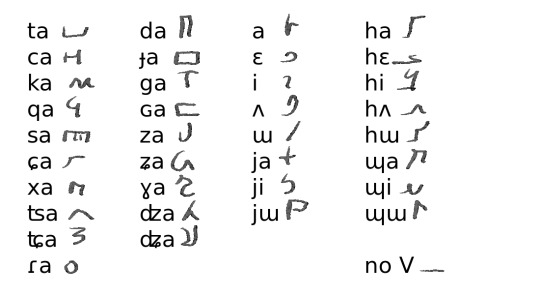
It's an abugida, written from top to bottom, left to right. "A" is a default vowel, it is only explicitly written when it occurs at the beginning of a word. The ɰ/h/j + vowel sequences are also treated as vowels.
Within a syllable unit, it is written from left to right too. The maximum size of such a syllable is CVV, where C is any consonant and V is a vowel or ɰ/h/j + vowel sequence.
Sometimes, consonants without a vowel get the "no V" line, but not always. It is only when a vowel disappears between two consonants that this is used. At the end of words, the vowel will be written but not pronounced. The lowering of i to ɛ and ɯ to ʌ in a closed syllable, the vowel deletion between r and a consonant, and the vowel deletion between a consonant and ɰ/j, are not written either.
Ashisota is a tonal language, but unlike what you might expect, tones are not written on the vowels. The tones arose because of consonant devoicing and various deletions. Originally voiced consonants create low tones and voiceless ones high tones. H was deleted and a high tone remained in the next vowel. Falling tones are created at the end of words where a syllable with a fricative was deleted, and the previous syllable had high tone. Even more complex tones can be formed by having multiple of these environments in succession.
12 notes
·
View notes
Text

Spell it phonetically, one grapheme per sound.
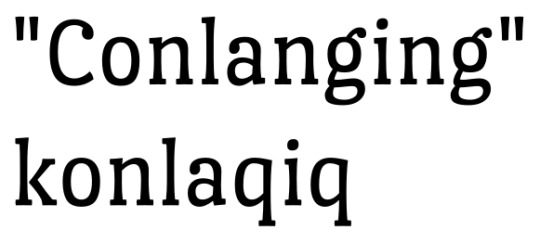
2. Write out consonants. Keep them each within one square. [In the fake history, imagine this writing system started out as an abjad.]

3. Arrange the consonants into a grid, 4 maximum. The consonant(s) you separate is context-dependent. Here, '-ing' is a suffix so we separate 'ng/q'.

[Here we have KNLQQ! But an English-based abjad can be difficult to follow.]
4. Write out vowels. Keep them each within one square.
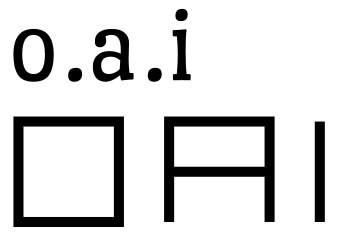
[But where do OAI go in KNLQQ? Oknalqiq? We need more guidance.]
5. Mark any vowel with a consonant in its coda with a line.
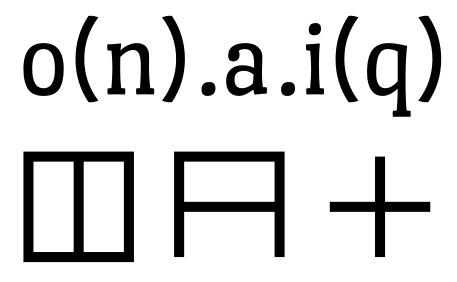
6. Arrange the vowels into a grid, 4 consonants maximum. [No need to separate the 'i' in '-ing' here.]
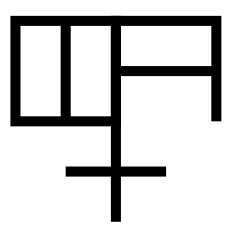
[Giving you KNLQ-Q O'AI', or KoNLaQiQ]
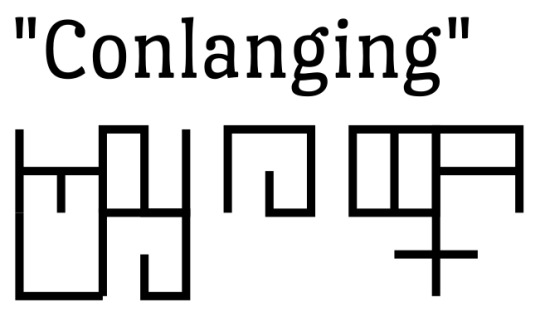
7. Write over the grid version with the circle tool.
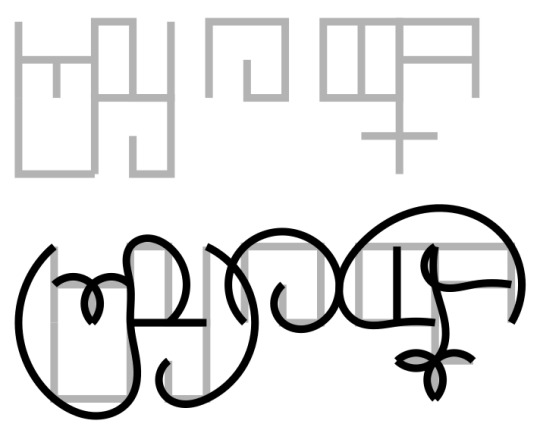
8. Put each character in an equal square.

9. Spruce up with variable lineweight to finish~!
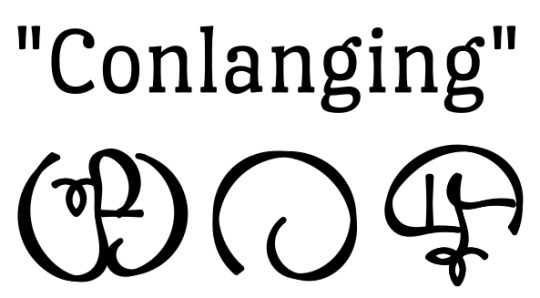
[And you can even read the original letters in the swirls if you know how to look.]

#conscript#conlang#constructed script#writing system#i've been playing with this swirly system for a while#now's as good a time as ever to show it off!#i do love making writing systems
5 notes
·
View notes
Text
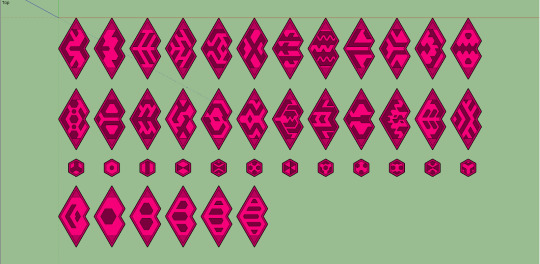
Open invitation/request for anyone with linguistics knowledge to critique my semi-conlang's alphabet?
For context, the top two rows are the letters, the third row is the punctuation, and the bottom row is numerals, operating on a base-6 system. The punctuation and numerals I'm pretty happy with, but the letters I want a second opinion on, as there are a few conditions I need them to satisfy that I'm not sure I succeeded in.
The first is a result of the writing system I came up with; sets of three letters form basically a syllable/phrase, which is written as a hexagon comprised of three diamonds sharing edges, (with the punctuation filling in the center space when applicable) and multiple hexagons are strung together to form more complex words. Thus as a result, the letters all have to be both unique from each other and easily identifiable in general from any angle, since they could be rotated around to fit any position in that shape depending on the word. (With some limitations placed on certain letter groups like vowels and stuff, but still) So as a result of that, most of them are mirrored to aid in the rotational recognizability, and I've tried to incorporate some recurring motifs for similar sounds,* while keeping each one more-or-less distinct.
*(I also have the sounds and letter types decided, but I am waiting to actually assign them to each character until I have the characters themselves finalized)
Unfortunately, I'm kinda afraid that in trying to satisfy those conditions, I somewhat failed in the third and probably most important one, which is having them actually feel like actual character symbols that an alien race would naturally develop over time. This is supposed to be a somewhat more artifically-created language specifically for use as a common unifying language taught alongside local/regional traditional languages, but it would still be pulling from some of those pre-existing ones. So with that in mind, while there is some leeway for artificiality in the characters, I still want most of them to be ones that would feel natural, not too complex or awkward to jot down. And just like, something that would reasonably feel like it's mostly the result of a long history of linguistic evolution, despite being recontexualized slightly for this common unified language. I feel like some of them work for that, but others I'm not so sure about, so second opinions and like, suggestions on how to improve some of them would be very helpful.
#not a reblog#linguistics#conlang#constructed language#alphabet#alien language#metroid silence#i say semi conlang mainly because most of it will be like translated#so stuff like most words and grammar would be irrelevant to really figure out#but there will still be proper nouns and stuff#and for those to feel meaningfully consistent and stuff#I needed to figure out the basic writing system and certain conventions#both for those aformentioned names#and for how that would impact aesthetic choices and whatnot
13 notes
·
View notes
Text
My sci fi worldbuilding: what if the only way to break the speed of light is tied to breaking systems of physics and logic so there’s a risk of everything collapsing conceptually in a surreal emotionally-based way
My urban fantasy worldbuilding: what if categorising magical creatures was a human construction and there wasnt much of a metaphysical difference between a fae, a yaoguai and a goblin
My superhero worldbuilding: wot if three or more magic/superpower systems. and we crash them into each other. repeatedly. And also nobody in universe knows what’s going on
#cadmus rambles#cadmus writes#its been a while since i talked about my original writing here#im not doing a lot of it but im addicted to worldbuilding#i suffer from the affliction where I believe categorisation systems are a human construction that don#t map neatly onto reality but also magic systems are fun in stories
11 notes
·
View notes
Text
Pinned post
Hi! My name is Arcee and I am a worldbuilder with a BIG interest in neography.
This blog is nothing more than a stash of ALL of my neographies that I have documented since I began doing neography by the beginning of 2022. You can view the scripts faster by using the archive.
Mainer blog is @thecrazyworldbuilder, visit it and also my other blogs, @444names, @cryptolangsguy, @schooloftieflings and @verical.
I will begin listing my neographies from the very beginning of the documented list, tagging each with the blog's tag, as well as couple more.
I have open commissions for artistic designs using my neographies, or I can create a neographic script for you!
If the project takes less than an hour to finish, you get the end result free of charge (accepting tips, you pay what you think the script is worth), longer than that depends on the amount of symbols and time spent designing the script; the standard English alphabet cipher with 26 symbols costs 30$.
On my pfp is Ahimiko, the mascot of this blog. She is an anthro canine of mixed heritage, and is a powerful symbolomancer (mage specializing in casting via projecting symbols of different kinds: the stronger the symbolism, the deeper the mysticism, and the more complex the symbol the more precise and specific is the spell she casts). Say hi! :D
Most of my scripts are purely ciphers for English. I do not care to make conlangs for every single one of them, for I enjoy the act of creation.
On creation: Some anon asked for the methods I use to create cohesive and constant-style scripts. A good post on my other blog might help, listing the methods.
NOTE THAT ALL OF MY CREATIONS ARE FREE TO USE, BUT YOU MUST CREDIT ME AS THE CREATOR/NOTIFY ME BEFORE USING THEM IN YOUR COMIC, ART, BOOK OR ANYTHING
As well - feel free to ask for assistance and guidance in usage of my scripts in DMs; Some of them lack explanation, and might be bit confusing.
ASK BOX RULES:
Refrain from using anonymous asks, since it cuts off the possibility of me responding more directly into your DMs if I deem them impossible to answer via post and won't be able to notify you about it, making me look rude.
You can send positive feedback - it will be stored in the bottom of this post (see below).
You can send requests for scripts, like "Futhark but more like Ogham", or "a Katakana chart inspired by Klingon". Those are free, unlike the commissions, hence I am not required to do adjustments, follow the idea 1:1, nor I am required to make them in the first place.
Don't ask for tips, guidance, or tutorials: This blog is purely an archive of my works. If you need help, go to @conlangcrab where I will answer your asks directly, just remember to address them to "Arcee", since the blog is run by two people there.
Updates on this post below:
I make neographic scripts for already existing writing systems (like Latin or Katakana) because I can't create a conlang for every single aesthetic I can come up with for a writing system.
By Ides of March, 2023, this blog has 350 distinct scripts documented, all created by me.
A pinterest user has been repeatedly stealing my works I've posted on Reddit without notifying or crediting me.
By 4/4/2023, there are over 400 scripts documented.
By 3rd of May, there are over 500 scripts documented.
By 27 of June, there are exactly 600 scripts documented.
By 7th of July, there are exactly 700 scripts documented.
By 25th of August, there are exactly 800 scripts documented.
Another pinterest user has been stealing my works from Reddit.
By 17th of October, there are exactly 900 scripts documented.
By 12th of November, there are exactly 1000 scripts documented.
By 23rd of December, there are exactly 1100 scripts documented.
By 2/10/2024, there are exactly 1200 scripts documented.
By 3/29/2024, there are exactly 1300 scripts documented.
Positive anon asks under the cut (you are encouraged to send more!)

<3
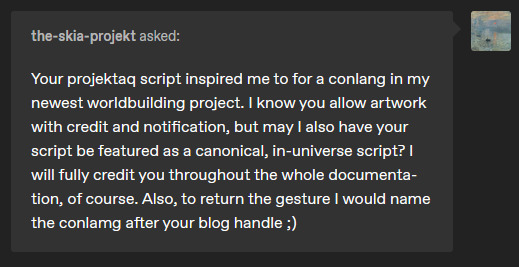
Sure thing! Thank you UwUb

Thanki ;w;b
Well, I do have some WIP or UFO (never meant to be finished WIPs) conlangs, but I don't have scripts for them really. I do ciphers because they are A) Simple to make, B) Are a good display of just enough symbol styles for a demonstration of an idea, thus, a good "advertisement" for my product, which are neographies.

QoQb
I will never stop indeed, as long as I can move my hands xD

In fact I answered this one, but didn't say thanks for the warm words Q~Qb
#neography#thecrazyneographist#ahimiko#thecrazyworldbuilder#cryptolangsguy#schooloftieflings#conscript#fantasy#writing system#neographist#neography key#conscripting#conscripts#constructed script
24 notes
·
View notes
Text
A script I've been working on, for private use. Exclusive.

Logographic, thus, each symbol is a word.
Sentence starter, designates standard width of the central column.
"Swoosh", works like a parentheses (like this) or a reference, footnote/comment*
Plural diacritic.
"Alpha-swoosh", connects to the symbol on the same column as the one it started on. Used as an en-dash (-), simplifier of compound glyphs, or a rebus word/poetic paraphrasing marker.
A phonoglyph diacritic. Meaning, the glyph represents the initial sound the original, logographic meaning/pronunciation has, which then replaces/adds to the second glyph coming afterwards. Used for words without a specific pronunciation or without an assigned logograph. Think of it like writing "lord" as "L(egacy)(W)ord".
A name group: Name placeholder glyph, link to pronunciation.
An adjective form marker. There's also a verb form marker. Glyphs are usually signifying but not restricted to nouns. If an adj. marker is applied to an adj. glyph, it negates itself and thus becomes a noun.
Swoosh column separator. Those are two separate sentences regarding different cases. Alternatively, this punctuation mark can be used as a comma.
A cartouche, name marker. A diacritic of sorts that alternates the pronunciation of a glyph to mean a proper noun rather a noun. Like "hunter -> Hunter" or "stone -> Peter".
Fullstop, aka period punctuation mark.
NOTE: this script is in development, and for this presentation, the style has been drastically altered. Here, only the mechanics of the writing system are listed.
The script also isn't purposed to be naturalistic, much, as the people using it have their own approach towards writing and philosophy. Though, some glyphs are indeed based on pictograms.
Am not looking for criticism or prompts, but I can't stop you from giving either anyways, so whatever.
*like this.
#worldbuilding#fantasy worldbuilding#neography#neographying#neography prompt#writing system#fantasy writing system#conscript#conscripting#constructed language
82 notes
·
View notes
Text
from this
Minho leveled him with a quizzical stare. When he spoke, his voice was heavy with confusion, as though he couldn't comprehend Thomas' insane stupidity. "You didn't actually expect him to survive, did you?"
"I don't know," Thomas whispered, and he hated how he felt like he was going to cry in that moment. He hated how Minho was looking at him like he was the biggest shuck idiot in the world. Frustrated, he snapped, "I guess I just had this cute fantasy where Ben ran off and lived happily ever after with the Grievers. Maybe even had tea with them on Sundays."
Sundays. When was the last time Thomas had a Sunday? Weren't you supposed to take a break from work on Sundays? Life in the Glade had blurred into one hazy nightmare. And they had certainly never had a Sunday before.
Minho shrugged, his shoulders loose, his entire demeanor careless. As if he wasn't holding the bloodstained remains of his closest Running partner.
So it came as a shock to Thomas when his next words were soft spoken and almost heartfelt.
"He's safe now."
"That's how it works down here." The words were out of Thomas' mouth before he could stop them. "Nobody here is safe until they're dead."
Minho shot him a puzzled look, which Thomas pretended not to notice. He wouldn't understand. He'd been here for too long. Lived in the Maze for too long. Had stopped noticing how ironic it was to call the graveyard a Safe Haven.
#just needed to get this out of my system. I don't know why I just. really needed to write this for some reason#Borrowing traits from the books and the movies is always fun. This is them finding Ben's shirt from the movie mixed with the#mixed with the careless attitude towards Banishings from the books. and... I guess also somewhat mixed with Dashner's shitty writing style#I think I accidentally emulated it here.#uhhhh#maze runner#ficlet#fanfic#fic#idk#I'm semi-ashamed of this I won't lie#I don't take constructive criticism because I'm not wrong
4 notes
·
View notes
Text
Introduction to Collective Seraphic
Now that Seraphic's at a stable place, I think I'm gonna take some time to delve into the basics of how it operates. For this post I'll only be going into the language itself and not the writing system, as that's going to need a post of its own to elaborate on. I'll try to keep this as concise as possible, but I may make separate posts expanding on topics discussed in this one. So, without further ado, onto the infodump!
Background
Collective Seraphic (which I'll be referring to as "Seraphic") is an artlang that I've created for a comic that as of this post I have not began yet, but am still developing. The majority of the comic will take place on the Seraph Homeworld, an alien planet some 3,000 lightyears from Earth populated by the seraph species (pictured below):

Within the story, Seraphic acts as the lingua franca of the Seraph Homeworld and the many colonized planets under Seraph control. It's used in the government, and among speakers of differing languages. As such, this language was the first one that I knew I would need to make as it will play a vital role in both the storytelling and narrative structure.
Syntax
Seraphic is largely a fusional language, employing affixes to modify the semantic role and meaning of morphemes. Seraphic does not, in the traditional sense, have verbs, so the sentence structure is strictly subject-object (will expand upon later). Nouns decline for number and tense, and are grouped into seven noun classes. Adjectives agree with nouns in number, except if derived from nouns themselves, in which case they'll also agree in class. Seraphic is very head-initial; with demonstratives, numerals, possesives, adjectives, genitives, and relative clauses following the noun the modify; and prepositions preceeding the nouns they modify. Auxiliaries preceed procedurals (again, will expand upon later).
Phonology
Here is the phonological chart for Seraphic:
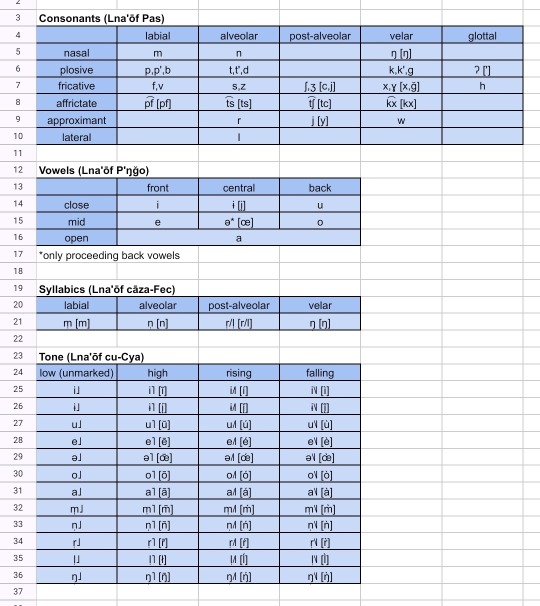
It has a syllable structure of (CC)V(CC). Plosives cannot exist word finally, clusters of consonants of the same manner are illegal, and vowel clusters are also not permitted. Syllabic consonants are grouped with vowels and behave much like them, carrying tone and stress, so they together are grouped and referred to as vocalics. Seraphic is a tonal language, employing the use of four tones: rising (á), falling (à), high (ā), and low (a). Low tones remained unmarked in both the Seraphic script and in romanization. Stress is syllable-independant. It will take either the ultimate, penultimate, or rarely the antepenultimate. Stress always falls on the syllable with a voiceless initial obstruent nearest to the end of the word. If none are available, it will fall on the syllable with an initial sonorant within the same parameters. Stress will never fall on a voiced obstruent. For clarity, I'll provide a key describing the pronunciation of the romanization.
Sounds that are similarly pronounced as they're read in American English:
m, n, p, b, t, d, k, g, f, v, s, z, y, w, l
Sounds that have special pronunciations:
ŋ, like the ng in English "sing"
p', like the ጴ in Amharic "ጴጥሮስ"
t', like the t' in Navajo "yá'át'ééh"
k', like the კ in Georgian "კაბა"
', like the the space within English "uh-oh"
c, like the sh in English "sharp"
j, like the s in English "measure"
x, like the gh in English "ugh"
ğ, like the γ in Greek "γάλα"
pf, like the pf in German "Pfirsiche"
ts, like the z in Italian "grazia"
tc, like the ch in English "chain"
kx, like the kh in Lakota "lakhóta"
r, like the rr in Spanish "perro", although occasionally like the r in Spanish "amarillo"
i, like the ee in English "meet"
į, like the ы in Russian "ты"
u, like the oo in English "boot"
e, like the é in French "beauté"
œ, like the a in English "Tina"
o, like the o in Classical Latin "sol"
a, like the a in English "bra" although this can change to be more forward or more backward.
Another letter that might trip people up is ł, which is meant to represent the high tone syllabic 'l'. Otherwise, syllabics are written the same as their pulmonic counterparts, with tone markers written when applicable.
Nouns
Nouns make up the bulk of the Seraphic lexicon. Every noun is grouped into one of seven classes:
Solar class: nouns related to seraphim or seraph-like beings, and seraph body parts. Prefix appears as zā-, zō-, zē-, s-, or ts-.
sēr = "person"
Astral class: nouns related to non-seraph animate lifeforms (their equivalent to "animals"). Prefix appears as ğr-, x, or kx-.
xuc = "cherub"
Vital class: nouns related to inanimate lifeforms (their equivalent to "plants"). Prefix appears as wā-, wō, w-, ū-, wē-, or wī-.
wējlux = "tree"
Terranean class: nouns related to landscapes, locations, and natural phenomena. Prefix appears as va-, vo-, vu-, f-, and pf-.
voxāl = "sun"
Metallic class: nouns related to inanimate objects, both natural and artificial. Prefix appears as ja-, jo-, c-, or tc-.
jağrú = "rock"
Lunar class: nouns related to abstract concepts, and terms related to time. Prefix appears as la-, lo-, le-, li-, y-, or l/ł-.
levren = "job"
Oceanic class: nouns related to general words, tangible concepts, numbers, all adjectives, and non-incorporated loanwords. Prefix appears as a/ā-, o/ō-, or aw-.
awuf = "group"
Adjectives do not agree in class, due to the fact that nouns originally are derived from adjectives, and noun classes acted as a way to differentiate between nouns and adjectives.
fa = "warm, hot"
jafa = "fire" (lit. "a hot thing")
When adjectives are used as predicatives, they decline into the oceanic class in order to take the procedurals (once more, will expand upon later).
Nouns also decline for four numbers: singular (one thing, usually unmarked), dual (two things, both things; suffixes as -ac, -oc, -œc, or -c), plural (things, many thing; suffixes as -n, -an, or -in), and collective (every thing, all things; suffixes as -āf/ōf, -áf/-óf, or -'ōf).
Seraphic doesn't use pronouns. Everything and everyone is referred to by name, including yourself. From our perspective, the Seraphic language constantly speaks in the third person. However, it can be repetitive to use the same name over and over again in a sentence, and sometimes you don't know the name of things, so they'll apply what I've called pro-forms. They consist of the demonstrative adjectives fl "this", sl "that", and xl "yon" declined into the Solar class and taking the place of the first, second, and third person respectively. For ease of reference, I'll provide the forms and their declensions below.
zāfl (I/me), zāflc (both of us), zāvlin (we/us), zāfláf (all of us)
zāsl (you), zāslc (both of you), zāzlin (you guys), zāsláf (all of you)
zōxl (they), zōxlc (both of them), zōğlin (many of them), zōxláf (all of them)
Seraphic makes no distinction in the gender of the speaker, in this regard. Although these resemble pronouns, they're not meant to be used as often as regular pronouns, and whenever possible it's much preferred that you refer to someone or something by name.
Adjectives and Prepositions
Adjectives are fairly straightforward. Adjectives follow the noun they modify (e.g. sēr tan "big person"), and agree with them in number (e.g. sēr tan "big person" vs sērn t'aŋon "big people"). Adjectives agree in the singular form with singular and collective nouns, and they agree in the plural form with dual and plural nouns.
There are three main types of adjectives: native adjectives (e.g. cna "good"), borrowed adjectives (e.g. anzn "nice"), and noun-derived adjectives (e.g. arfi/ofi "new"). Native and borrowed adjectives don't agree with noun classes, but noun-derived adjectives do. It originated from the animacy-based adjective agreement system in Proto-Seraphic, which has been lost in all other adjective instances. When you want to make a noun into an adjective you'll affix one of two prefixes to it: ar- (if agreeing with Solar, Astral, and Vital nouns) and o- (if agreeing with Terranean, Metallic, Lunar, and Oceanic nouns). There are specific rules on the forms each prefix takes based on the noun they're attached to:
"ār-" when preceeding high or falling vocalic syllables (e.g. sēr ārzājna "popular person")
"ar-" when preceeding low or rising vocalic syllables (e.g. wēn arfe "local fruit")
"ó-" when preceeding high or falling vocalic syllables (e.g. lalel ówē "grassy flavor")
"o-" when preceeding low or falling vocalic syllables (e.g. lesar olvulvren "economic problem")
"ōw-" when preceeding words that start with a vocalic (e.g. lnin ōwāsāvbas "momentary event")
Prepositions occur before the nouns they modify, and don't change form in any circumstance. There are currently 19 prepositions in the modern language, and they are usually connected to nouns via a hyphen (e.g. e-fe "at (the) place"):
cu = of; indicates possession
pr̄ = indicates the indirect object, equivalent to "to" in the phrase "The man sends the letter to me."
in/īn = as or like; indicates similarity or resemblance. Will either be low or high tone depending on the tone of the following syllable.
e/ē = at or on; indicates location.
tsa = near or for; indicates relative distance from a location or an action performed for the sake of the referent.
cni = without; indicates a lack of possession or company.
wa = in or inside of; indicates interior position.
tn = on top of, above, or before; indicates superior position or a prior instance in time.
pux = under, beneath, or after; indicates inferior position or a following instance in time.
pi = with, together with; indicates being in company of or making use of the referent.
fān = from or away from; indicates the motion of leaving the referent.
ku = out of; indicates motion from within the referent towards the exterior.
tun = into or through; indicates motion from outside the referent towards the interior.
xel = to or towards; indicates the motion of approaching the referent.
kxun = across; indicates motion from one location to another
pn̄ = around; indicates location surrounding the referrent.
cāza = between; indicates location in the middle of the referrent.
tē = after, behind; indicates posterior position.
fr = during; indicates a moment in time
Prepositions aren't combined in Collective Seraphic, but may be in certain instances in colloquial speech.
Procedurals
Okay, this is probably the most complicated part of Seraphic, so I'm going to need to get into things individually. First, I'll start with defining a procedural itself. Procedurals are the term I use for the prefixes used to describe the relationship or process of and between the agent noun and the patient noun. These are what act as the equivalent to "verbs" in earth languages. There are three in use:
Existential: used to denote a state of being or equivalence between agent and patient, or to the patient and itself. Equivalent to English "to be" (e.g. A is B, there is B). Usually prefixes as some variant of n-, m-, or ŋ-.
Actional: used to denote an action or process between the agent and patient, or with the patient and itself. Equivalent to English "to do" or "to act upon" (e.g. A acts upon B). Carries a connotation of agency and intent. Usually prefixes as some variant of re-, ra-, or r-.
Resultative: used to denote an occurence or change in state between agent and patient, or patient and itself. Equivalent to English "to become", "to happen", or "to change into" (e.g. A becomes B, B happens to A). Carries a connotation of passiveness or motion. Usually prefixes as some varient of ed- or ez-.
The procedural will change its form slightly depending on the class and declension pattern of the noun it modifies. It always affixes to the patient noun, demonstrating a relationship of an action and what is being acted upon. In this way, the patient can be clearly identified. In transitive or causative clauses, the word order is always S(P)O, with the agent acting as the subject and the patient as the object. In intransitive and passive clauses, the word order is always (P)S, with the patient acting as the subject and the agent demoted to the indirect object or omitted entirely.
Although seemingly limiting, using these three procedural, as well as prepositions, nouns, and adjectives, altogether can be used to make all sorts of verb equivalents that are called "procedural phrases". I'll demonstrate how to build a sentence now. First thing we need to know is the subject and object:
Sāx ... jafa (The child ... the fire)
Next, I'll add the actional procedural in the present tense to this.
Sāx rejafa (The child acts upon the fire)
By itself this is technically grammatically correct, but it doesn't really mean anything. It's too broad. So we add a prepositional phrase to specify exactly what action the child is taking towards the fire.
Sāx pi-sīman rejafa (The childs acts upon the fire with (their) eyes)
Now we know that the child is performing an action involving the use of their eyes. Now of course this could mean many different things in English, but in Seraphic the first thing that comes to mind would be fairly obvious: to see! Thus, "Sāx pi-sīman rejafa" would be the same as saying "The child sees the fire" in English! There are a lot of set phrases that equate to verbs, and remain consistent in their arrangement. Often differing phrases are a useful way to ascertain where someone is from or what their first language is.
Tense and Aspect
Seraphic has six main tenses: two pasts, two presents, and two futures. The two pasts consist of the recent past (happening recently) and the remote past (happening a long time ago), and they prefix and/or combine with the procedural.
Sāx pi-sīman ğrejafa (The child just saw the fire)
Sāx pi-sīman eğrejafa (The child saw the fire a while ago)
Similarly, the future tenses consist of the near future (will happen soon) and the distant future (will happen eventually).
Sāx pi-sīman drejafa (The child will soon see the fire)
Sāx pi-sīman izrejafa (The child will eventually see the fire)
The present tenses consist of a general present tense (happens) and the infinitive (to happen) which is used with auxiliaries and copulae and carries no presence in time.
Sāx pi-sīman rejafa (The child sees the fire)
Pi-sīman ezrejafa (To see a fire)
Whether someone considers an event to be nearer or farther in time from them is completely up to their discretion. There's no set timeframe for when to use the recent vs. remote past, it's all fairly subjective. However, whether you decide to use the recent or remote can really indicate whether you believe something to be in the distant past or future, or just a few moments ago or soon.
Seraphic also makes use of two copulae, the perfective -r and the imperfective -l, helping clitics that expand on the aspect of the procedural, i.e. how the procedural happens over time instead of when in time. The copulae are separate from the procedural, being placed directly before it and conjugating on their own similarly to the lexical procedural. When the copulae are in use, they are conjugated instead of the lexical procedural, while the lexical will be put into the infinitive. The exception to this is if the point in time is considered necessary to be stated for the sake of clarity or emphasis, in which case the lexical verb will also conjugate (though this isn't considered to be the default). The two copulae each conjugate to six tenses, and give 12 individual aspects in total. They are as follows, starting with the perfective:
āgxōnr - Pluperfect: indicates that the action happened at a point before some time in the past either specified or implied (e.g. āgxōnr nidsl "that has happened")
xōnr - Preterite: indicates that the action happened in the past with no reference to if it was completed recently or remotely. A general past (e.g. xōnr nidsl "that happened")
nar - Relative: indicates relative clauses, i.e. clauses that act to modify a noun similarly to an adjective. Equivalent to "that", "who", or "which" (e.g. lsl nar nidsl "the thing that happens")
ednr - Gnomic: indicates general truths, common knowledge, and aphorisms (e.g. ednr nezłsl "things happen")
t'enr - Future Simple: indicates the action will happen in the future with no regard to how near or far it is from the present (e.g. t'enr nidsl "that will happen")
āt'ēnr - Future Perfect: indicates that the action will happen before a time or event in the future (e.g. āt'ēnr nidsl "that will have happened")
And the imperfective:
ŋ̄xōzl - Discontinuous: indicates that an action was happening in the past, but is no longer happening in the present (e.g. ŋ̄xōzl nidsl "that used to happen")
xōzl - Habitual: indicates that an action is done often or out of habit (e.g. xōzl nidsl "that always happens")
īzl - Progressive: indicates that an action is happening at the very moment of conversation (e.g. īzl nidsl "that is happening")
nizl - Prospective: indicates that an action will be starting to, or is in the process of happening (e.g. nizl nidsl "that is about to happen")
t'ezl - Iterative: indicates that an action happens again, repeatedly, or more than one time based on context (e.g. t'ezl nidsl "that happens again" or "that happens again and again")
nt'ezl - Continuative: indicates that an action happens continuously and without end (e.g. nt'ezl nidsl "that still happens")
With both tense and aspects, this largely expands the capability of Seraphic in referring to time.
Moods
Seraphic makes use of seven modal particles to denote seven moods. They are always placed at the beginning of clauses, and no two modal particles can exist in the same clause. They are grouped into four categories: the declaritive (indicative and negative), the inferential (evidential and interrogative), the deontic (volitive and imperative), and the epistemic (subjunctive and conditional). They add extra clarity in the speakers mood or opinion concerning the clause they modify, and are as follows:
Indicative: base form of a clause. Indicates that the speaker is stating a fact or what exists, and is unmarked (e.g. idsl "that happens")
tu - Negative: indicates that the speaker is stating a fact that is untrue or what doesn't exist. Usually only appears in formal, official texts, as the first syllable of the procedural will chage tone to contrast as well and leaves the particle unneccesary in colloquial speech (e.g. tu īdsl "that doesn't happen")
cuc - Evidential: indicates that the speaker is stating a fact that they believe or understand to be true, regardless of having experienced it or not. (e.g. cuc idsl "apparently that happens") Direct evidentiality is denoted using a different method.
an/ān - Interrogative: indicates that the speaker is confirming whether a statement is or isn't true. Forms questions (e.g. an idsl? "does that happen?")
tcān - Volitive: indicates that the speaker desires for the statement to be true (e.g. tcān idsl "that wants to happen" or "that needs to happen" or "that should happen")
má - Imperative: indicates that the speaker is giving a command or suggestion, to themselves and/or to other referents. Functions additionally as a cohortative and a jussive (e.g. má idsl! "let that happen!")
tir - Subjunctive: indicates that the speaker believes the statement to be possible or likely (e.g. tir idsl "that could/would/might happen")
nun - Conditional: indicates that speaker believes the statement to be possible under specific circumstances or conditions (nun idsl "if/when that happens..."
Miscellaneous
That's about the basics of the Seraphic language outline. I'd like to eventually get into things like comparison, evidentiality, declension forms and the like, but those are all topics that definitely need their own individual posts. Real quick, I want to provide one more additional fact about Seraphic.
Seraphic uses base-16, meaning it groups numbers in sets of 16 instead of sets of 10 like we do. 1-16 would be written 1, 2, 3, 4, 5, 6, 7, 8, 9, A, B, C, D, E, F, 10. 10 would be read as 16, and equally 20 would be 32. They're still counting the same amount of things, they're just dividing it up differently!
Anyways that's about it, I hope to share more about Seraphic soon, and when the comic gets released I hope you'll all be able to read it and pick out the many many lines of Seraphic I've poured into it!
ŋKowīci cu-stux 'ōf tsa-levp'ā cu-zāsláf pi-lizt'n ğōdjasa! (Thank you all so much for reading!)
#conlang#constructed language#artlang#grammar#phonology#syntax#linguistics#seraphic#collective seraphic#info post#hope i didn't make a fool of myself in front of the whole community#accidentally showed the world i dont know shit abt linguistics gotdamn#im sure itll be fine#writing system tutorial forthcoming
19 notes
·
View notes
Text
I can't read the aj book reviews on goodreads though because I feel like people collectively did not get that the gender thing was A) in service to her other themes not the entire point of the book B) not a girlboss everyone's a woman now thing either
#maybe the idea started like oh what if i just used she pronouns for everyone but the writing is more nuanced than that#it's the empire taking over different cultures it's not like universally a good thing#it's what many of the characters grew up with so it doesn't occur to them that they could be a different gender#it's not a universally bad thing either it's not like the book goes 'oh the empire is wrong not to have two specific genders'#it's just like. in the same way this empire enforces gender and restricts bodily autonomy through constant surveillance#your empire does the same to you. it's just like asking you to question things#but some characters have no problem with their given pronouns. it's all socially constructed that's the point#breq was probably the first time i was really envious of someone's gender though#there's no like. status significance to her pronouns in her culture. she doesn't wear different styles based on it#then you see her having to translate herself to other people's expectations when she's outside of the empire#and she's constantly botching it even after 20 years#never related to someone's experience with gender more#it's like i don't really do that. lol. but you're welcome to interpret me however. it is simply none of my business#i'll be whatever is most convenient when i'm trying to rent a place to stay. assigned woman at rental application#i never agreed to this system it's just a weird cultural quirk that makes my life slightly worse but otherwise isn't important to me
12 notes
·
View notes
Text
FUCK IT. WE BALL
little thing I wrote for @misty-wisp!! about batsu au Omori and 11:11 pm au Sunny meeting. for funsies
“Hello?” called Sunny as loud as he could. He’s been wandering around these strange woods for quite some time now. ‘There’s so many dead trees… but a lot of overgrowth at the same time… how strange!’ he thought as he scanned his surroundings.
“…Who are you?” a voice behind him suddenly asked. Sunny quickly turned around to face them, hiding the delicate flower behind his back.
“Oh, uhm, hi! I’m Sunny! Well, not your Sunny, but, uh, yeah…” his voice gradually grew quieter as he nervously toed the ground. ‘Didn’t expect him to be so tall...!’
“Oh… hello. I’m Omori. Nice to meet you…” he mumbled as he looked away, shifting slightly. ‘Oh no, he seems nervous… I hope I didn’t make him uncomfortable… Better get this over with, quick!’
“Well, uh, I know I’m not your Sunny, but… uhm… I just came here to tell you I know what it’s like to think you don’t deserve forgiveness! So, here!” the colourful boy forced out as he quickly shoved a white chrysanthemum towards the monochrome one.
“I forgive you, and I hope you’ll forgive yourself too…”
…
“Thank you…” Omori seemed to whisper as he gently took the white chrysanthemum, looking down at it in wonder.
Sunny looked up in relief, glad Omori seems to appreciate his gift. “Well, I should be going now… Bye!” and off he went before he could embarrass himself further. ‘Why does socializing have to be so hard! Oh well, gotta get back to Mari…!’ Omori looked up from the gift, but Sunny was already gone. He looked back down at the flower and smiled softly. ‘Maybe things will be okay.’
#cringe fail writing mdsfhgjhdkajskKUASHKJ /neg sorry needed to get that out of my system <3#uhm anyways#constructive criticism is fine as long as it's actually constructive!!#so nothing like 'this sucks' please#tell me what I could improve with and how!! ty..#also no explanation for how Sunny even got there it doesn't matter <3#okay time to hide for 5 hours /hj /lh#others aus#chimera writes#oh I should tag my au#omori 11:11 pm#11:11 pm au
17 notes
·
View notes